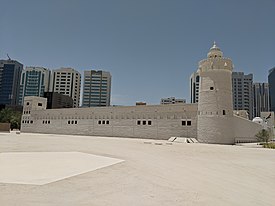| Qasr Al Hosn | |
|---|---|
 Qasr Al Hosn in May 2019 Qasr Al Hosn in May 2019 | |
| Location | Sheikh Zayed the First Street |
| Coordinates | 24°28′57″N 54°21′17″E / 24.48239°N 54.35482°E / 24.48239; 54.35482 |
| Built | 1931 outer Fort with 30 m high main watchtower around the 1761 inner fort |
 | |
The Qasr Al Hosn (Arabic: قصر الحصن, Qaṣr al-Ḥuṣn, "Fortified Palace") is a historical landmark and the oldest stone building in the city of Abu Dhabi, the capital of the United Arab Emirates. Its construction was supervised by Mohammed Al Bastaki in 1761.

Location
It is located along Rashid Bin Saeed Al Maktoum St and is a part of the Abu Dhabi Cultural Foundation.
History
Qasr Al Hosn, also known as the White Fort (originally not white in colour but painted bright white during 1976–1983 renovations) or Old Fort, was constructed in 1761 as a conical watchtower to defend the only freshwater well in Abu Dhabi island. The tower was later expanded into a small fort in 1793 by the then ruler, Shakhbut bin Dhiyab Al Nahyan, and became the permanent residence of the ruling Sheikh. The tower took its present shape after a major extension in the late 1930s, aided by revenues received for granting the first oil license in Abu Dhabi. It remained the emir's palace (hence the name Qasr Al Hosn, meaning Palace fort) and seat of government until 1966. The fort had been refurbished several times and is now partially open to the public.
Current use
The Qasr Al Hosn is currently the subject of extensive historical, archaeological, and architectural research. The fort houses a museum displaying artifacts and pictures representing the history of the country. It also has a range of weapons, used through the region's history, on display.
Qasr Al Hosn festival

Qasr Al Hosn festival is an annual 11-day cultural event staged on the grounds of the fort. The fort is open to the public during the festival, including some of the restricted areas and features live music and dance performances showing the UAE's cultural heritage.
References
- "قصر الحصن حارس تاريخ أبوظبي". صحيفة الخليج (in Arabic). Retrieved 2021-01-26.
- ^ "UAE museum: Qasr Al Hosn in Abu Dhabi". Gulf News. 2 November 2008. Retrieved February 12, 2015.
- "QASR AL HOSN - Abu Dhabi Culture". Cultural Foundation. Retrieved April 22, 2019.
- ^ "National". National. 12 February 2015. Retrieved February 12, 2015.
- ^ "My destination". My destination. 2015. Retrieved February 12, 2015.
- "Dubaifaqs". Dubaifaqs. 22 April 2014. Retrieved February 12, 2015.
- "UAE Interact". UAE Interact. 29 July 2007. Retrieved February 12, 2015.
- ^ "Khaleej Times". Khaleej Times. 12 February 2015. Archived from the original on 12 February 2015. Retrieved February 12, 2015.
- "Muntada Qasr Al Hosn serves as key platform". Gulf News. 2 March 2013. Retrieved February 12, 2015.
- "Festival home". Qasr al Hosn Festival. 2015. Retrieved February 12, 2015.
- ^ "Take a trip down memory lane at Qasr Al Hosn". Gulf News. 11 February 2015. Retrieved February 12, 2015.
External links
- Frauke Heard-Bey (2004). From Trucial States to United Arab Emirates. Motivate Publishing. p. 540. ISBN 9781860631672.
- Reem El Mutwalli (1995). Qasr al Husn, An Architectural Survey. Royal Publishing House.
- Jayanti Maitra (2001). Qasr al Hosn: The History of the Rulers of Abu Dhabi 1793–1966. National Center for Documentation and Research. p. 262. ISBN 978-1860631054.
- Official Website
| Cities and areas |
|
|---|---|
| Municipal regions | |
| Government | |
| Culture | Cultural property of national significance in Abu Dhabi |
| Transport |
|
| Infrastructure | |
| History | |
| Sister Cities | |
24°28′57″N 54°21′17″E / 24.48239°N 54.35482°E / 24.48239; 54.35482
Categories: